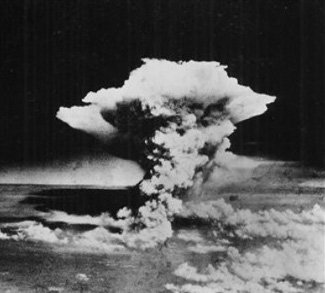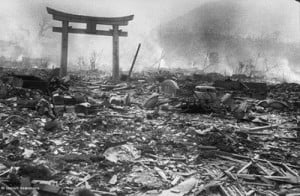Nuclear Weapons Have Been Used Quite Regularly
The United States has a long history of threatening other nations with its nuclear arsenal.

Note to readers: please click the share buttons above
The world famous American outlaws, John Dillinger and Alphonse Capone, would have quickly understood the thinking behind their country’s nuclear weapons policy. In the post-World War II era, successive United States governments have used nuclear weapons in a similar manner to armed gangsters who embark upon robbing a prestigious bank.
Dillinger, for instance, in his attempts to steal money from various vaults across America waved a gun at anybody foolish enough to raise their voice. Yet Dillinger – who was noted for having particularly high intelligence – would have been loath to fire his weapon, most often a Colt .38 Super automatic or a Colt Monitor, unless he felt clear reason to do so. Dillinger once said to the terrified employees and customers of a bank,
“Now nobody get nervous, you ain’t got nothing to fear. You’re being robbed by the John Dillinger gang, that’s the best there is!”
Despite his global fame and notoriety, Dillinger was charged with just a single homicide in his short life – and even that came during a shoot-out, in 1934, with a police officer in Indiana who opened fire on Dillinger first, striking his bullet-proof vest, before the outlaw responded. During his reign, Dillinger is estimated to have stolen about $500,000, today worth more than nine million dollars.
This sum is a pittance by comparison to the money pilfered by corrupt bankers and developers across the West, who escaped being branded with “Public Enemy Number One” status, unlike Dillinger or Capone. Nor did they have waves of armed policemen and FBI agents hunting them either; in fact, in many cases the white-collar, business class criminals are let off with a rap on the knuckles, with the general population forking out to gloss over the mess. Such is the way the world works.
The effective use of guns in targeting banks, despite the weapons very seldom being fired, draws comparisons with America’s nuclear war strategy. The widely held belief that nuclear bombs have been used only twice in human history is something of a myth, to say the least. Nuclear weapons are utilized quite regularly by methods which would have been easily recognized by Dillinger, Capone, Pretty Boy Floyd, Jesse James and other household name criminals.
Quite similar to how the Dillinger gang cowed bank workers and customers with their guns, successive US governments have threatened to unleash nuclear weapons upon disobedient states, in order to get what they want. Award winning author and military analyst Daniel Ellsberg, explains that,
“For a certain type of gun owner, getting their way in such situations without having to pull the trigger is the best use of the gun. It is why they have it, why they keep it loaded and ready to hand. All American presidents since Franklin Roosevelt have acted on that motive, at times, for owning nuclear weapons: The incentive to be able to threaten to initiate nuclear attacks if certain demands are not met”.
Ellsberg lists over two dozen instances during which nuclear weapons were used by successive US administrations dating back to Harry Truman (1945-1953) – the same president who authorized the criminal bombings of Hiroshima and Nagasaki, then lauded the decision afterwards.
This included the threat to drop more atomic bombs on Japan should she not surrender in the aftermath of the Nagasaki attack, on 9 August 1945. Emperor Hirohito announced Japan’s capitulation just six days later, on 15 August, which came as a surprise to many in the Japanese military, who were eager to continue fighting.
For a second time, in June 1948, at the outset of the Berlin Blockade, the nuclear threat was used by president Truman when he deployed “atomic capable” B-29 heavy bombers to US bases in Britain and Germany. The Soviets, who had no atomic bombs at this point, heeded the warnings and refused to challenge the blockade by the air, which the Truman administration ranked as a success.
For a third time, on 30 November 1950, Truman threatened to unleash atomic bombs after Communist China entered the Korean War. The Americans had suffered the “loss of China” in 1949 following a Mao Zedong-led revolution, an outcome that infuriated Truman in particular, who as a young man expressed his disregard for the “Chinaman”. Truman even declared during the press conference in late November 1950 that, “There has always been active consideration of its use”, referring to the atomic bomb. Words that ring true to the current day. The president was replying (very honestly) to the following question from a reporter, “Does that mean there is active consideration of the use of the atomic bomb?”
In 1953, president Dwight D. Eisenhower threatened China with atomic attacks in order to “maintain a settlement” in Korea. During the first Quemoy crisis (September 1954-May 1955), Eisenhower agreed to a last resort nuclear weapon usage against China, which was relayed to the Communist nation in various statements and military moves. It quickly led to the negotiated resolution of the armed conflict.
In 1956, Eisenhower’s vice-president Richard Nixon put forward “Diplomatic use of the Bomb” to warn the USSR against interfering in the Suez Crisis. Two years later, 1958, during the Lebanon Crisis Eisenhower sent a secret directive to the US Joint Chiefs of Staff, to prepare nuclear attacks in preventing Iraq from moving into oil-rich Kuwait. Again in 1958, Eisenhower directed another covert message to the Joint Chiefs of Staff to attack China with nuclear weapons if the Chinese Communists invaded the Quemoy islands.
By the late 1950s, nuclear attacks had come to have a more sinister meaning, all kept secret from the general populations of course. The weapons were no longer of the atomic variety, but had been “upgraded” to hydrogen bombs, some of which are a thousand times more powerful than those dropped on Japan. They were, and are, explosive enough to incinerate the world.
As the postwar years advanced, the use of nuclear weapons through intimidation and threats continued abreast. During the October 1962 Cuban Missile Crisis, the world came perilously close to a terminal nuclear war between America and the USSR. The “most dangerous moment” was mainly due to the Kennedy administration’s hegemonic policies, including a failed 1961 invasion of Cuba and the perpetration of an extensive terrorist war against the Fidel Castro-led nation, called “Operation Mongoose” – one of the key factors that resulted in the missile crisis.
Another crucial element was Castro’s fear of a second US invasion which, by no coincidence, was scheduled for October 1962. Soviet president Nikita Khrushchev, who respected Castro, sent his nuclear missiles to Cuba genuinely hoping to prevent the Cuban revolution from being terminated. With the American nuclear threats escalating Khrushchev withdrew his missiles, but not without further possibility of nuclear war.
In 1968, president Lyndon B. Johnson was advised by his Joint Chiefs of Staff of possible nuclear weapon attacks to defend US Marines surrounded at Khe Sanh, South Vietnam. During 1969 and the early 1970s, president Richard Nixon put forward the potential usage of nuclear bombs against the North Vietnamese, as relayed to the Communists by Henry Kissinger, National Security Advisor.
In October 1973, president Nixon put Strategic Air Command on high alert in order to deter the Soviets from intervening in the Arab-Israeli War. The US outlined to the Soviets their willingness to oppose them by force, including risking full-scale nuclear war that would have destroyed the earth. The USSR heeded the warnings.
In August 1980, during the Jimmy Carter presidency, the possible imminent use of “tactical” nuclear weapons against the USSR was relayed if the Communist superpower invaded Iran – as was conveyed in secret, and explicitly, by the Americans to the Soviet leadership. In late 1979, the USSR had intervened in neighboring Afghanistan, disastrously so as it would turn out.

Clockwise from top: USAF F-15Es, F-16s, and a F-15C flying over burning Kuwaiti oil wells; British troops from the Staffordshire Regiment in Operation Granby; camera view from a Lockheed AC-130; Highway of Death; M728 Combat Engineer Vehicle. (Source: Wikimedia Commons)
In January 1991, the George H. W. Bush administration put forward serious nuclear threats against Saddam Hussein‘s Iraq, during the US-led “Operation Desert Storm”. Hussein had, unwisely, disobeyed his Western masters by invading oil-rich Kuwait in August 1990.
In 1995, the Bill Clinton government forwarded secret, and explicit, nuclear threats to North Korea with regard the Communist state’s nuclear reactor program. The year before, president Clinton had been on the brink of ordering a conventional land invasion of North Korea, which was flattened by the US military in the early 1950s.
The other examples that Ellsberg outlines are, as he explains, “most of the actual nuclear crises that can now be documented for the last half of the twentieth century”. The full list is even longer.
The English historian and author Edward P. Thompson wrote that,
“It has never been true that nuclear war is ‘unthinkable’. It has been thought and the thought has been put into effect”.
Should a deliberate or unanticipated event trigger the American (or Russian) nuclear arsenal, it would result in the human species almost being wiped out, due to the ensuing nuclear winter resulting in an irreversible global famine.
*
Shane Quinn obtained an honors journalism degree. He is interested in writing primarily on foreign affairs, having been inspired by authors like Noam Chomsky. He is a frequent contributor to Global Research.
 Can you help us keep up the work we do? Namely, bring you the important news overlooked or censored by the mainstream media and fight the corporate and government propaganda, the purpose of which is, more than ever, to “fabricate consent” and advocate war for profit.
Can you help us keep up the work we do? Namely, bring you the important news overlooked or censored by the mainstream media and fight the corporate and government propaganda, the purpose of which is, more than ever, to “fabricate consent” and advocate war for profit.
We thank all the readers who have contributed to our work by making donations or becoming members.
If you have the means to make a small or substantial donation to contribute to our fight for truth, peace and justice around the world, your gesture would be much appreciated.


